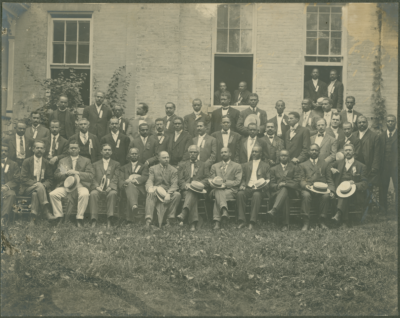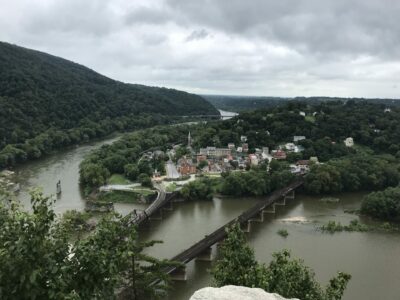Editor's Note
Today’s guest post is by Leah Baer, who is a masters student in Public History at American University. She has worked on projects for the National Park Service, National Council for Public History, and Arlington National Cemetery. Her BA is from Bryn Mawr College.
At the confluence of the Shenandoah and Potomac Rivers in Harpers Ferry, West Virginia stands a modest fire engine house. On October 16, 1859, John Brown, a staunch abolitionist, led eighteen men across the B&O Railroad Bridge with the intent of capturing the Federal Armory and Arsenal at Harpers Ferry and freeing enslaved men and women in the local area. From there Brown planned for his army to advance south along the Appalachian Mountains and spark a larger uprising.[1] The events that ultimately transpired fueled sectional tensions and sanctified the engine house, now referred to as John Brown’s Fort, within historical memory. Recollections of the raid continue to evoke sentiments of horror and admiration. Events organized at Harpers Ferry in 1906 and 1959 typified this duality by presenting to the public disparate interpretations of John Brown.
Brown arrived in the region on July 3, 1859 to devise a plan for the raid. He acquired a farm five miles from Harpers Ferry and began amassing supplies. By October, Brown recruited twenty-one men to join his army. Five were African American. The raid commenced at 8:00pm on October 16, 1859. Within two hours, Brown and eighteen of his men captured the Federal Armory and Arsenal along with the U.S. Rifle Works on the nearby Hall’s Island. The first casualty occurred sometime around 1:30 am on October 17 when a raider shot and killed Heyward Shepherd, a free African American working as a porter for the B&O Railroad. Speculation around what occurred between Shepherd and the raiders continues to persist. By 7:00am the following day, Brown’s men began holding hostages and employees of the armory in the fire engine house. Citizens of the town and members of the local militia armed themselves, recaptured the U.S. Rifle Works, freed most of the hostages, and forced Brown and some of the remaining raiders to barricade within the fire engine house. At 11:00 pm, Colonel Robert E. Lee and 90 Marines arrived. The ensuing standoff culminated in the Marines storming the engine house the following morning. They killed two of the raiders and captured five others, including John Brown. On November 2, 1859, a jury found Brown guilty of murder, treason, and conspiring to incite insurrection.[2] On the day of his execution, in a note to his jailer, Brown issued his most famous words: “I John Brown, am now quite certain the crimes of this guilty, land: will never be purged away; but with Blood. I had as I now think: vainly flattered myself that without very much bloodshed; it might be done.”[3]
In 1906 the leaders of the Niagara Movement – precursor to the NAACP – chose to host their second annual meeting at Storer College, a historically black college in Harpers Ferry. It included daily meetings, speeches, and other commemorative events. W. E. B. Du Bois, one of the founders of the Niagara Movement, allocated a full day to commemorate the legacy of John Brown. The day began with a pilgrimage to John Brown’s Fort.[4] After reaching the site, participants removed their shoes and socks and marched in a procession around the structure while singing “The Battle Hymn of the Republic” and “John Brown’s Body.”[5] Later in the day, members gathered for another rendition of “John Brown’s Body” and a speech conducted by Reverend Reverdy C. Ransom. In his speech titled, “The Spirit of John Brown,” Ransom framed Brown’s actions within a religious context.[6] Ransom proclaimed: “He was commissioned by the same authority and bore the same credentials as did Moses. […] he delivered a blow against slavery in the most vital part, and fired the gun whose opening shot echoed the sound of the death knell of slavery.”[7] By referencing the influence of God as the reason for the raid, Ransom enforced the significance of religion in Brown’s life and challenged the assumption that insanity drove him to lead the raid.
Attendees also heard a speech by Henrietta Leary Evans, the older sister of Lewis Sheridan Leary and aunt of John Copeland. Leary and Copeland were two of the five Black members of the raid.[8] Reports of the event highlighted her ability to captivate the crowd with a short speech centering the participation of Leary and Copeland in the raid. She emphasized that bravery and a desire for freedom inspired the men to join Brown’s Army. Following the meeting the members visited a neighboring town, Charles Town, to collect souvenirs relating to Brown’s final days.[9]
On the last day of the conference, Du Bois presented a resounding speech that projected the demands of the movement and urged members to harness the spirit of John Brown and his fellow raiders. In the conclusion of his speech, Du Bois said, that “we do not believe in violence, but we do believe in John Brown, and here on the scene of John Brown’s martyrdom we reconsecrate ourselves, our honor, and our property to the final emancipation of the race which John Brown died to make free.”[10] By hosting the meeting at Harpers Ferry, Du Bois both emphasized the sanctity of the physical space and contextualized the contemporary civil rights movement within the legacy of John Brown’s Raid.
The following year the leaders of the Niagara Movement again submitted a petition to the President of Storer College, Henry T. McDonald, to host their annual meeting at the school. As a result of allowing the the Niagara Movement to host their 1906 meeting at the school, white patrons decreased their donations and the West Virginia State Legislature decreased the annual funds allocated to Storer.[11] McDonald responded to Du Bois: “I do not think that the Niagara Movement in way has injured this institution, there are some who will not agree with me and in view of the unexpected lessening of our annual appropriation, there might seem to be a foundation for their argument.”[12] McDonald agreed to inform Du Bois of the school’s decision after a Board of Trustees meeting. But he never did, and the lack of an answer compelled the leaders of the Niagara Movement to host the next annual meeting in Boston.[13]
In years leading up to the centennial of the Civil War, President Eisenhower approved a joint resolution for the establishment of the Civil War Centennial Commission (CWCC) in 1957. When Karl S. Betts, a leader of the commission, learned about the National Park Service’s plan to host a centennial event to commemorate John Brown’s Raid he petitioned the agency to alter its agenda. On October 6, 1958, Betts called Charles W. Porter, the Acting Chief Historian of the National Park Service (NPS), arguing that a celebration of the raid was not conducive to the mission of the CWCC or the current political and social climate and requested they “soft-pedal” the event. The NPS quickly adhered to the demands of the CWCC and transferred responsibility to the Harpers Ferry Area Foundation (HFAF). Local citizens formed the organization in the wake of the NPS forfeiting the initial commemorative plan. The HFAF organized a new event called the Centennial Observance John Brown’s Raid. [14]
The obvious change from commemoration to observance underscored a theme of neutralizing efforts that permeated the event. The four-day event commenced on October 15, 1859 and was attended by a predominantly white crowd of 65,000 people. This effectively ruined the plans of the CWCC to devalue the historical significance of the raid.[15] The first day ended with the opening performance of Dr. Edwin Wallace Dace’s play The Prophet, a dramatization of the life of John Brown.[16] It replaced the famous last words of John Brown with an actor portraying a member of the Virginia militia screaming “So perish all such enemies of Virginia! All such enemies of the Union! All such foes of the human race!”[17] The following day included a luncheon hosted by historians deemed experts on John Brown. While the panel was supposed to engage in an intellectual debate, the questions posed by NPS Staff Historian, J. Walter Coleman reinforced the CWCC’s disregard and contempt for the legacy of Brown. Some of the questions Coleman asked included: why did men follow John Brown on such a reckless scheme with no promise of results, should John Brown have been declared insane, and why did mainstream New Englanders fund his ventures.[18]
The 1906 Niagara Movement conference consecrated John Brown and interpreted his actions as necessary to achieve emancipation. The 1959 Centennial Observance created a spectacle to perpetuate a subjective ideology that aligned with public memories of the Civil War that failed to recognize the centrality of slavery. The contrasting interpretations of John Brown’s Raid presented in 1906 and 1959 elucidates the enduring controversy over who can claim this hallowed ground and how historical events associated with the space appear within public memory.

Niagara Movement delegates at Storer College in Harpers Ferry on August 17, 1906. Photo courtesy of Department of Special Collections and University Archives, W. E. B. Du Bois Library, University of Massachusetts Amherst.

Photo of Harpers Ferry, West Virginia, by Leah Baer
[1] “John Brown,” American Battlefield Trust, https://www.battlefields.org/learn/biographies/john-brown.
[2] “John Brown’s Raid,” NPS, last modified December 27, 2017, https://www.nps.gov/articles/john-browns-raid.htm.
[3] “John Brown,” American Battlefield Trust.
[4] Niagara Movement Second Annual Meeting Program Copy 2, 1906. W. E. B. Du Bois Papers. Special Collections and University Archives, University of Massachusetts Amherst Libraries.
[5] James Koenig, “The 1906 Niagara Movement at Storer College,” in “To Emancipate the Mind and Soul”, Storer College, ed. Catherine Baldau (Harpers Ferry: Harpers Ferry Park Association, 2017), 90.
[6] Koenig, “The 1906 Niagara Movement at Storer College,” 91.
[7] Reverdy C. Ransom, “The Spirit of John Brown” (speech, Harpers Ferry, W.V., August 17, 1906), Hathi Trust, https://babel.hathitrust.org/cgi/pt?id=emu.010002588180.
[8] Eugene L. Meyer, Five for Freedom: The African American Soldiers in John Brown’s Army, (Chicago: Lawrence Hill Books, 2018), 185.
[9] J. Max Barber, “The Niagara Movement at Harpers Ferry,” Voice of the Negro, October 1906, 410.
[10] “The Niagara Movement’s Address to the Country, ” New York Times, August 20, 1906.
[11] Andrew W. Kahrl, “The Political Work of Leisure: Class, Recreation, and African American Commemoration at Harpers Ferry, West Virginia, 1881-1931,” Journal of Social History 42, no. 1 (2008): 71.
[12] Letter from the President of Storer College to W. E. B. Du Bois, March 18, 1907. W. E. B. Du Bois Papers (MS 312). Special Collections and University Archives, University of Massachusetts Amherst Library.
[13] Kahrl, “The Political Work of Leisure: Class, Recreation, and African American Commemoration at Harpers Ferry, West Virginia, 1881-1931,” 71.
[14] Anne C. Kretsinger-Harries, “Commemoration Controversy: The Harpers Ferry Raid Centennial as a Challenge to Dominant Public Memories of the U.S. Civil War,” Rhetoric and Public Affairs 17, no. 1 (2014): 83-5, https://doi.org/10.14321/rhetpublaffa.17.1.0067; Nona Brown, “John Brown Raids Again,” New York Times, October 4, 1959, http://www.wvculture.org/history/jbexhibit/timescentennial.html.
[15] Kretsinger-Harries, “Commemoration Controversy: The Harpers Ferry Raid Centennial as a Challenge to Dominant Public Memories of the U.S. Civil War,” 85.
[16] Program, “Centennial Observance: John Brown Raid.”
[17] Carl Irving, “Harpers Ferry Prepares to Mark Centennial of John Brown’s Raid,” Evening Star, September 7, 1959.
[18] Kretsinger-Harries, “Commemoration Controversy: The Harpers Ferry Raid Centennial as a Challenge to Dominant Public Memories of the U.S. Civil War,” 90.

0